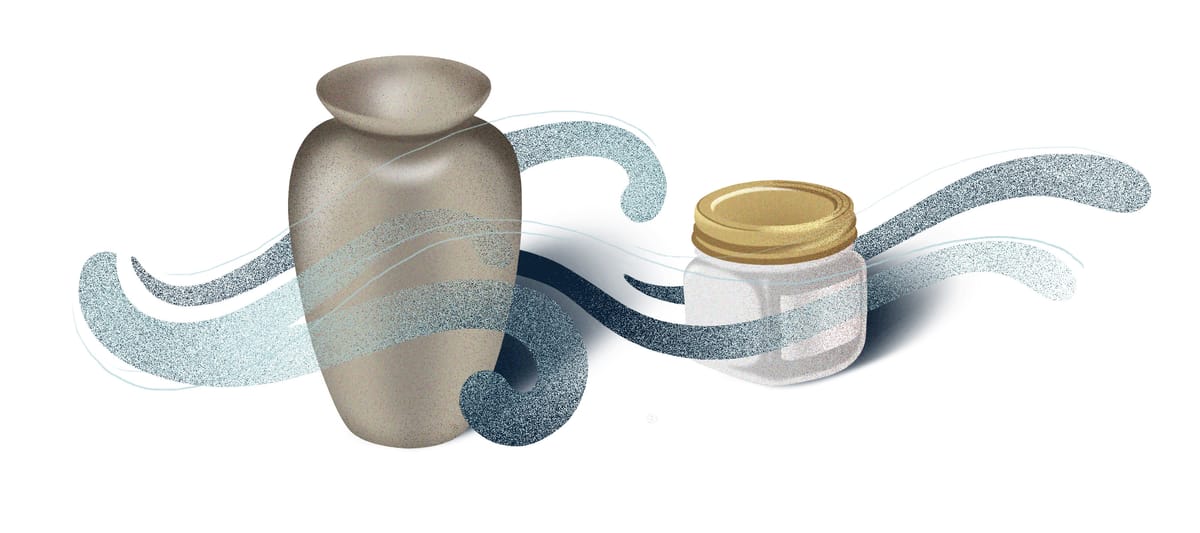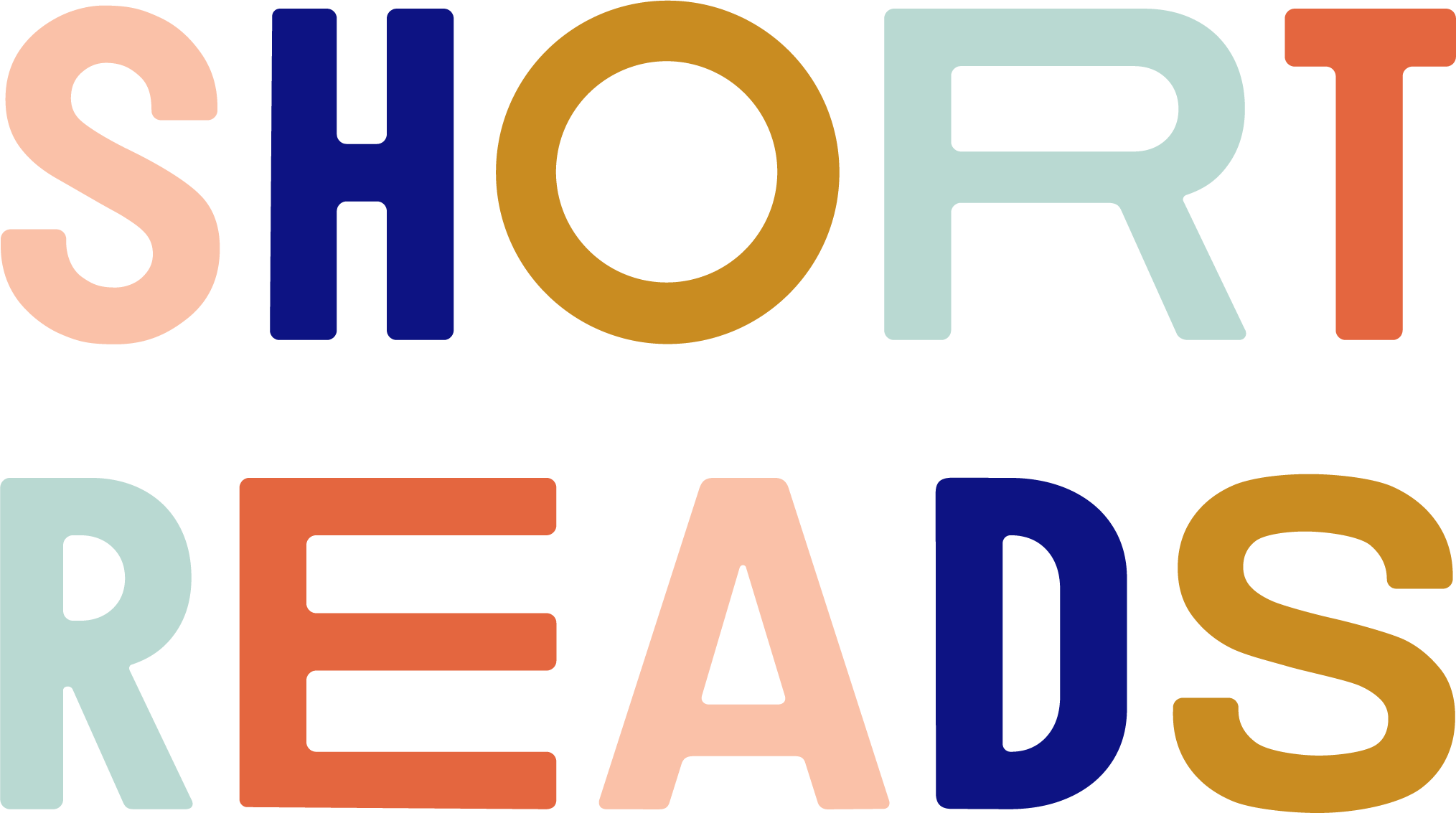Legacy
by Katy Rank Lev | The lessons we pass on.

My mother kept a scoop of her mother’s ashes in a jam jar in the console of her car. Mostly because she never remembered to take the jar inside, but she also found comfort in its tinkling presence.
As she drove around, the jar rolled among the gum and Mariah Carey CD cases. It might have been a bottle of aspirin or hand sanitizer, but it wasn’t: It was a black-cherry jam jar repurposed to hold my grandmother’s cremains.
My grandmother passed away from dementia in her late eighties. Everyone had lots of time to prepare for this inevitability, but still my mother was devastated by grief when it finally happened—until it was time to organize the funeral. Then, with a task at hand, she switched into “go mode,” as women do.
She and her sisters wrote the obituary and designed the printed bulletin, and when they heard the price of an urn, they dispatched my uncle to do what my family does best: bargain hunt.
“Always check Amazon first” became my mother’s most important talking point, along with “always wear clean underwear” and “always make sure your pants pockets are pushed in smooth.” No conversation was complete without one of these reminders.
We transferred my grandmother’s cremains into the Amazon urn, bound for Connecticut, where she was interred beside her late husband.
But my mother set aside a scoop of ashes in the jam jar, because we had a plan for them.
A few months after the funeral, we gathered the extended family at a glassblowing studio in Lancaster, where we made paperweights fused with flecks of my grandmother’s carbonized bones.
Twenty of us huddled around the furnace, crafting vibrant green and blue keepsakes, and agreed this was a nice way to grieve.
“Let’s do this every time one of us dies,” we joked.
~~~
I don’t remember much about the days and weeks following my mother’s death. I know, of course, I ordered her urn from Amazon.
I felt like that was the only piece of guidance I had left.
I paid more in shipping than for the urn itself, but I didn’t want to stick her in a yogurt tub for her own memorial service.
Obviously, we grabbed the jam jar with the scant leftovers of my grandmother—turns out glassblowing doesn’t use much—and placed her on the entry table at the funeral home, beside the mints.
I couldn’t tell you what else happened at the funeral or who was there or if I responded when my children misbehaved.
But I remember scooping a bit of my mother’s cremains into a jam jar before I headed home.
If you’ve never handled human ashes, you might not know how they feel—silky and so fine that the puff of dust from opening the double plastic bag from the crematorium threatens to suffocate you where you stand.
There are also chunks among the superfine dust, and it’s hard not to stare at the bits and wonder what they used to be.
It was really hard, logistically, to transfer the ashes from the crematorium bag to the jam jar, and I’ll just go ahead and confess I used Mom’s gravy ladle and then left it in the urn because that seemed best.
I did break tradition a bit: I opted not to leave my ash jar in my minivan with the Lego and the diaper wipes.
Instead, I placed it on the mantle in the dining room, where it seemed to judge the chaos of my household and served as a constant and present reminder of unfinished business.
It took me two years to organize the glassblowing.
I sometimes wonder what she’d think of my taking so long to finish such important work, but she herself only had to live one year without her mother.
I like to think she’d understand.
Pulling together twenty family members from different states is no easy feat, and grief brings out all of our worst behavior, and I didn’t have my mother to call and talk me off the ledge whenever someone said or did something shocking.
My aunts needed the glassblowing to happen, because it was the final thing we knew she wanted from us.
I think it took me so long because once it was done, where did that leave me?
The glassblower was lovingly patient with my family. We drove to his studio with a scoop of ashes from the urn; I couldn’t bear to part with my jar stash, so I used the gravy ladle one last time to transfer some cremains to a separate jar.
The glassblower met each of our requests: an ashen snail for my middle son, a rose for one aunt, a swirling black tempest of an egg for me.
We gathered, we blew glass, we joked about the Amazon urn, and then what?
My jam jar of ashes has stood watch on my dining room mantle for a decade now, and I feel myself slipping into some of Mom’s habits.
I have a gift drawer so I’m never caught off guard by a late birthday party invitation.
I started reading romance novels, and just like her, I sometimes start one only to realize I’ve already read it.
Recently, I made my dad prepay for his own cremation, which really felt like I was honoring her dual legacies of advance planning and making my father do things he hates.
I did decline a two-for-one urn special that Amazon emailed me about, but as I now lean into my crone years, I’ve begun to wonder what wisdom I’ve imprinted onto my own children.
The jar has companions. My mother’s ashes are flanked by a sandwich baggie of fur from a beloved rabbit and a condiment cup containing the molt of a departed spider.
The cabinet above our toaster oven overflows with receptacles: vintage Tupperware from Mom’s house, metal cookie tins, cream cheese containers without lids. A cascade whenever anyone opens the cupboard looking for a vessel to contain our leftovers—the things we want to preserve.
Katy Rank Lev is a USA Today bestselling author of contemporary romance, writing under a pen name. She holds an MFA in creative nonfiction from the University of Pittsburgh, where she teaches composition. She lives in Pittsburgh with three feral sons, two rescued rabbits, and one tired husband.
This essay is a Short Reads original.
Want more like this? Subscribe to Short Reads and get one fresh flash essay—for free—in your inbox every Wednesday. Or become a supporting subscriber and help us pay writers.






